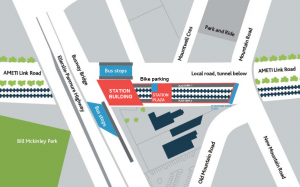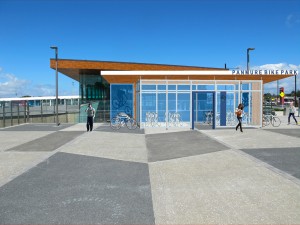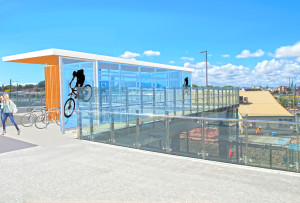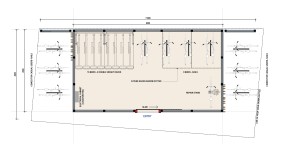Our blog and AT’s survey published last month about bike parking at train stations focused on a possible design for Panmure Train and Bus Station. AT received 75 survey responses on the proposed design, which was pretty good when you consider how hostile the cycling routes are to and from the Panmure Station. This is being worked on as part of the AMETI project, but it will be a couple of years before we see the changes needed for safer cycling.
Respondents come from all over Auckland, but very few live in easy reach of Panmure . Once again, this was not surprising. However, it is a super classy station, and since opening has gone from being the 18th most used station on the rail network to the 10th. AT is keen to complete the Station with permanent bike parking providing good weather protection, lighting and security.
Just to refresh your memory – here’s some info on the proposed design.
The survey gave 2 options for the bike parking layout; both have space for a repair stand. Option 1 has a parking for a total of 36 bikes – 12 on outdoor spaces and 16 bikes on double height stacked bike racks, plus 8 bikes on standard racks. Option 2 has the same setup for 12 bikes on outdoor racks and space inside for 16 bikes on 8 standard ground level racks.
At this stage lockers for bike gear are not proposed, although this was mentioned as a desirable feature by some respondents and disliked by others.
Option 1 –
Option 2 –
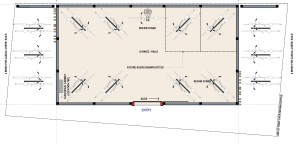 The survey results provide widely contrasting views on the good and bad features of the design. These were not always easy to follow or to give effect to. For example –
The survey results provide widely contrasting views on the good and bad features of the design. These were not always easy to follow or to give effect to. For example –
- Likes – 48 respondents listed a range of good features, including the weather shelter provided by the roof and walls, the CCTV security, the bike repair stand, the outdoor option providing ‘park and run’ spaces, the simple, clean design, the glass walls giving visibility into the shelter, the number of bike racks and the space efficiency of the double height racks. A couple of respondents simply noted they appreciated being consulted and were pleased new bike parking is coming.
- Dislikes – 54 respondents stated dislikes such as the limited number and inefficient layout of the bike racks, the ‘overkill’ , costly design, the likelihood the glass walls would be vandalised, the lack of security (including lack of HOP card swipe access, the narrow width of the door and possibility for congestion and entrapment within the shelter, the lack of weather cover for the outdoor spaces, the difficulty of using double height racks and the risk that they would fail and damage bikes on the lower level. A few said there was nothing to like about the design and that bike parking didn’t need weather protection at all.
The location of the facility is not in contention; it was favourably commented on by some respondents, and disliked by none. Only one person questioned the need for a roof for the shelter, and most specifically stated their support for having weather protection, including the shelter provided by the walls. Some people suggested a larger overhang would be useful for the outside racks.
The issue of security is reasonably straightforward, as the security of having a shelter with good visibility and CCTV was most favoured. The need for a lockable facility was raised by a few, but it was on the condition of making is accessible by a HOP card. This is a hugely expensive item to add, and is not warranted by the feedback.
Taking the survey results as a whole, along with the comments made to our bike parking at public transport blog series posted late last year, our survey for AT at the Northern Expressway stations last year and a project we have recently done Generation Zero, I consider we have some simple principles to work on.
Tomorrow I’m meeting AT’s staff who are working with us on this project. I’m keen to explore the scope and weatherproofing impact of reducing the extent of the front wall and/or widening the door to give easier and quicker access to the bike racks. Another feature worth exploring in my view is extending the overhang for the outdoor bikes and at the front of the structure.
You’re welcome to comment on this and any of the subjects raised above, or to email me, barbcuth@gmail.com.

